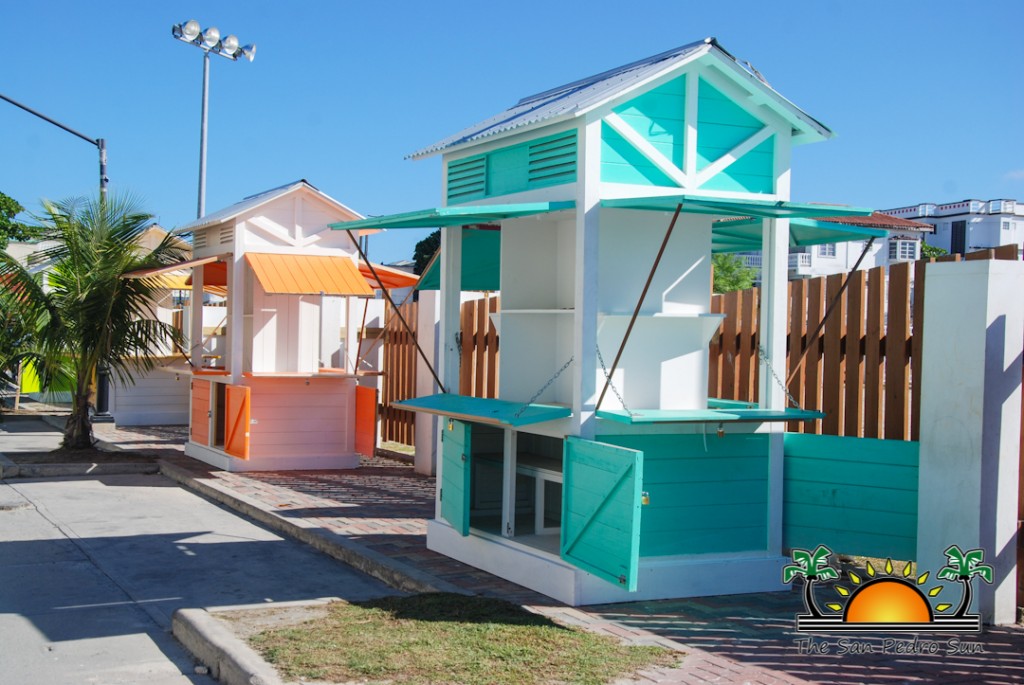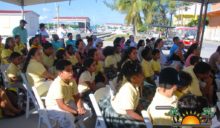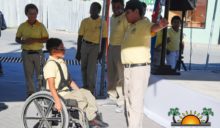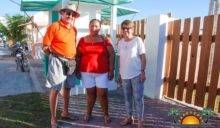With support from the Caribbean Local Economic Development Project (CARILED), The San Pedro Town Council (SPTC) was finally able to launch the second phase of its Artisan Market Area project on Tuesday, February 14th. This second phase aims to relocate artisans/vendors that continue doing business on the beaches of the island to the area around the Honourable Louis Sylvestre Sporting Complex. In the first phase of the project, artisans were relocated from the Central Park to booths in an open area on Angel Coral Street. This time, the other artisans will be provided with colourful kiosks with display windows, lockers and proper wiring for lighting.
The official ceremonies of the launch saw the presence of students from the Ambergris Caye Elementary School (ACES), Mayor Daniel Guerrero, representatives from CARILED, staff from the SPTC and members of the community.
Ruben Gonzalez, Councillor of local development at the SPTC gave the welcome remarks, emphasizing the importance of the tourism industry on the island. He claimed that the new phase of the project will enhance the image of the tourism product on the island. “Everything that we do, from the fruit vendor, tour operators, the receptionist, influences the tourism product on Ambergris Caye,” said Gonzalez. “If we are to remain an active player in the regional tourism destination, we at the local level must do everything within our jurisdiction to refine our tourism product.” He mentioned that the SPTC has been actively engaged in the local development of the island, following the process introduced by CARILED in the region.
Liedi Urbina, CARILED Country Coordinator, acknowledged that the input from the organization has made tremendous impact in San Pedro Town. “We have worked together with San Pedro for the past two years with the aim to stimulate local economic growth,” said Urbina. “The process has been simple; we work closely with the local municipality government and help them be the leaders in the projects.” According to her, it has been the contributions and ideas of the community that has made this second phase possible.
“I am happy about this project,” she exclaimed. “This new infrastructure on this second phase will provide a better more, adequate place for the artisans to sell their products.”
Next to take the podium was CARILED Program Coordinator, Marion Villanueva. She stated that local development is a vision of the community and the essence of its future is to work together. “We need to unite in order to provide a good product and a great experience to the visitors,” said Villanueva. “CARILED operates in seven different countries around the region. In Belize, this project in San Pedro started late, but I am amazed at the outstanding progress.” She also announced that CARILED will be pulling out of Belize around April of this year, but she is hopeful that another program will come into the country to continue aiding local development. She is confident that San Pedro, with or without CARILED, will be successful in its future endeavours.
Mayor Daniel Guerrero thanked CARILED for their support to the island during the past two years. He also took the opportunity to thank the artisans for their patience and working along with the local authorities. “This new program has introduced a new approach to local development, empowering the local government. We now have a better understanding of our local economy,” said Guerrero. “We have also been able to better identify the driving aspects of our economy and have a clear vision as to where we want to see the island in the next 15 to 20 years.” Guerrero believes that by working together with the artisans, this industry will see major improvements on the island. “This project is just the beginning, but if we want to reap the desired results, we must work together. More participation by the community will definitely be welcome,” he said.
During intermissions ACES students made a few presentations, highlighting some of the major issues the island is going through, such as traffic and the street conditions. They also made presentations focusing on a united community that overcomes any obstacles.
Of the 16 kiosks ordered, 14 have made it to the island, featuring tropical colours that complement the town’s atmosphere. According to Guerrero, the cost of the kiosks, including transportation to the island and assembling electrical wiring was a bit over US$21,000. This was covered by the SPTC, CARILED and Mahogany Bay Development. In the meantime, the Belize Tourism Board is contemplating in joining the cause so more kiosks can be ordered.
Before the activities concluded, a third phase of the project was announced. It will comprise of training sessions for the artisans, so that they can enhance the ability to brand their products and provide good customer service.
The issuing of the kiosks is still in process, as the designated artisans will need to be identified. However, the SPTC invites them to visit their offices on Barrier Reef Drive` for more information.








